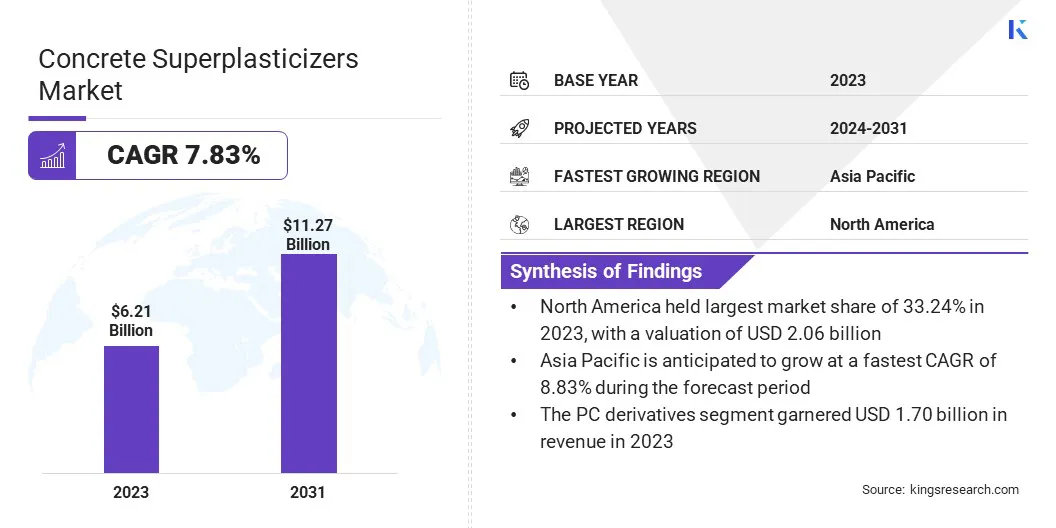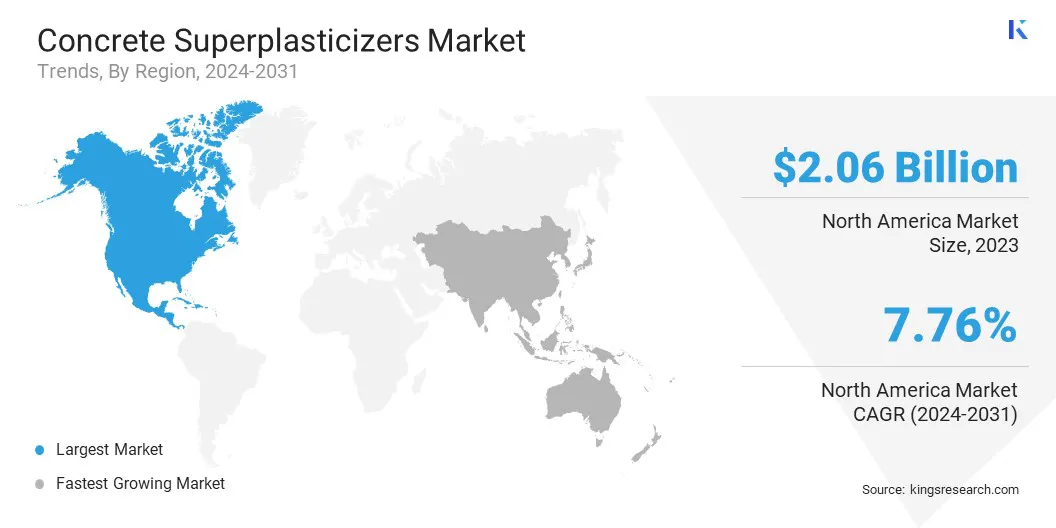Market Definition
The market involves the production and use of chemical admixtures that significantly reduce water content in concrete mixtures without affecting workability. These admixtures are typically formulated using sulfonated melamine-formaldehyde, sulfonated naphthalene-formaldehyde, or polycarboxylate ethers.
Superplasticizers improve early strength, durability, and surface finish while enabling complex formworks and reduced labor. Their usage is prevalent in precast structures, bridges, tunnels, and large-scale commercial and infrastructure projects where precision and strength are critical.
The report provides a comprehensive analysis of key drivers, emerging trends, and the competitive landscape expected to influence the market over the forecast period.
Concrete Superplasticizers Market Overview
The global concrete superplasticizers market size was valued at USD 6.21 billion in 2023 and is projected to grow from USD 6.65 billion in 2024 to USD 11.27 billion by 2031, exhibiting a CAGR of 7.83% during the forecast period.
The market is driven by the expansion of urban infrastructure projects, which demand high-performance concrete for complex architectural designs and dense reinforcement.
Additionally, increasing investments in transport infrastructure, such as highways, bridges, and rail systems are boosting the demand for durable and workable concrete solutions, thereby driving market growth.
Major companies operating in the concrete superplasticizers industry are Sika AG, BASF, Master Builders Solutions Holdings GmbH, GCP Applied Technologies Inc., Mapei S.p.A., Arkema, Kao Corporation, Fosroc, Inc., Enaspol a.s., Rhein-Chemotechnik GmbH, Binzhou Chengli Building Materials Co., Ltd., Kima Chemica Co. Ltd., Hangzhou Lans Concrete Admixture Inc., Euclid Chemical, and Saint-Gobain.
Rising urbanization is driving the need for vertical infrastructure, leading to an increase in high-rise residential and commercial buildings in major cities. These developments demand advanced concrete solutions, thereby fueling the adoption of superplasticizers to meet structural and performance requirements.
As a result, the global market is being driven by increasing demand for high-performance construction materials that support efficient, durable, and scalable urban infrastructure.
 Key Highlights:
Key Highlights:
- The concrete superplasticizers industry size was valued at USD 6.21 billion in 2023.
- The market is projected to grow at a CAGR of 7.83% from 2024 to 2031.
- North America held a market share of 33.24% in 2023, with a valuation of USD 2.06 billion.
- The PC derivatives segment garnered USD 1.70 billion in revenue in 2023.
- The powder segment is expected to reach USD 6.39 billion by 2031.
- The ready-mix concrete segment secured the largest revenue share of 37.37% in 2023.
- Asia Pacific is anticipated to grow at a CAGR of 8.83% during the forecast period.
Market Driver
"Expansion of Urban Infrastructure Projects"
Rapid urbanization across emerging economies is accelerating investments in transportation systems, high-rise buildings, and smart city infrastructure. These developments demand durable concrete mixes that are capable of maintaining strength and flow characteristics under tight deadlines and design complexities.
The use of superplasticizers supports faster project execution and enhances concrete workability in high-density areas. This shift in construction practices contributes to the growth of the concrete superplasticizers market.
- For instance, Saudi Arabia’s NEOM project, developed under the Vision 2030 initiative, is a large-scale smart city aimed at economic diversification. Spanning roughly 10,000 square miles, it includes developments like The Line, a linear city, and OXAGON, a high-tech industrial hub. These projects depend on advanced construction solutions, including concrete superplasticizers, to meet modern engineering and sustainability standards, further driving demand in the global market.
Market Challenge
"Inconsistent Quality of Raw Materials"
A major challenge affecting the growth of the concrete superplasticizers market is the inconsistent quality of raw materials, which affects the performance and compatibility of admixtures with different cement types. This variability complicates formulations and lead to reduced effectiveness on-site.
To address this, companies are investing in advanced quality control systems and conducting rigorous compatibility testing during product development. Leading manufacturers are also collaborating with cement producers and construction firms to tailor superplasticizer formulations for specific regional cement compositions, ensuring consistent results and improving end-user confidence in product performance across diverse construction conditions.
Market Trend
"Increasing Investment in Transport Infrastructure"
Governments and private entities are heavily investing in expanding highways, rail networks, bridges, and airports. These infrastructure projects require consistent concrete quality and efficient workability for quicker construction and long-term structural integrity.
Superplasticizers support these objectives by facilitating smooth placement and reduced labor requirements. The reliance on admixtures to meet stringent performance standards in transport construction is significantly contributing to the expansion of the concrete superplasticizers market across developed and emerging nations.
- In April 2025, the U.S. Department of Transportation finalized an agreement for USD 150 million to support the development of a new roadway and Port of Entry facility in the San Diego–Baja California border region.
Concrete Superplasticizers Market Report Snapshot
|
Segmentation
|
Details
|
|
By Type
|
PC Derivatives, Sulfonated Naphthalene Formaldehyde (SNF), Sulfonated Melamine Formaldehyde (SMF), Modified Lignosulfonates (MLS), Others
|
|
By Form
|
Liquid, Powder
|
|
By Application
|
Ready-Mix Concrete, Precast Concrete, High Performance Concrete, Others
|
|
By Region
|
North America: U.S., Canada, Mexico
|
|
Europe: France, UK, Spain, Germany, Italy, Russia, Rest of Europe
|
|
Asia-Pacific: China, Japan, India, Australia, ASEAN, South Korea, Rest of Asia-Pacific
|
|
Middle East & Africa: Turkey, U.A.E., Saudi Arabia, South Africa, Rest of Middle East & Africa
|
|
South America: Brazil, Argentina, Rest of South America
|
Market Segmentation:
- By Type (PC Derivatives, Sulfonated Naphthalene Formaldehyde (SNF), Sulfonated Melamine Formaldehyde (SMF), Modified Lignosulfonates (MLS), and Others): The PC derivatives segment earned USD 1.70 billion in 2023 due to its superior dispersing ability and extended workability, which make it suitable for high-performance and sustainable concrete mixes used in modern construction projects.
- By Form (Liquid and Powder): The powder segment held 56.84% of the market in 2023, due to its longer shelf life, ease of handling during transportation, and suitability for use in remote or dry-mix applications.
- By Application (Ready-Mix Concrete, Precast Concrete, High Performance Concrete, and Others): The ready-mix Concrete segment is projected to reach USD 4.17 billion by 2031, owing to its widespread use in large-scale infrastructure and commercial projects.
Concrete Superplasticizers Market Regional Analysis
Based on region, the market has been classified into North America, Europe, Asia Pacific, Middle East & Africa, and Latin America.
 The North America concrete superplasticizers market share stood around 33.24% in 2023 in the global market, with a valuation of USD 2.06 billion. North America's focus on rehabilitating aging infrastructure, particularly in major metropolitan areas, is creating a significant demand for high-performance concrete.
The North America concrete superplasticizers market share stood around 33.24% in 2023 in the global market, with a valuation of USD 2.06 billion. North America's focus on rehabilitating aging infrastructure, particularly in major metropolitan areas, is creating a significant demand for high-performance concrete.
Projects involving the repair of highways, bridges, transit systems, and underground utilities increasingly require concrete with enhanced workability and strength. This growing need for restoration solutions is accelerating the growth of the market in this region.
- The U.S. Department of Transportation announced the 22nd Street Revitalization project in Tucson, which involves replacing a bridge. The project is supported by a USD 25 million grant and includes a new structure spanning the Union Pacific Railroad.
Green building certifications such as LEED (Leadership in Energy and Environmental Design) and WELL are widely implemented across North America. These frameworks require construction materials to meet strict environmental and health-related benchmarks, including reduced cement usage, lower emissions, and greater durability. Concrete superplasticizers help achieve these targets by enhancing workability and performance, thereby driving market growth.
The Asia Pacific concrete superplasticizers industry is poised for significant growth at a robust CAGR of 8.83% over the forecast period. Rapid urbanization across key Asia Pacific cities is fueling a substantial rise in the construction of high-rise residential and commercial buildings.
These vertical structures involve complex designs with dense reinforcement and long pumping distances, necessitating the use of high-strength, flowable concrete. This is significantly driving the demand for concrete superplasticizers across the region.
Additionally, the region is experiencing major investments in industrial corridors and special economic zones (SEZs), aimed at enhancing manufacturing capacity and export competitiveness.
Such large-scale infrastructure projects, including roads, warehouses, and utility installations require durable, high-performance concrete. Superplasticizers are increasingly being integrated into these projects to improve early strength and reduce setting time, thereby driving the growth of the market in Asia Pacific.
Regulatory Frameworks
- The U.S. follows ASTM C494/C494M, which specifies requirements for chemical admixtures in concrete, including superplasticizers. This standard outlines performance criteria such as compressive strength, setting time, and durability. Compliance ensures that admixtures meet the necessary quality and performance standards for use in concrete applications.
- The EU utilizes the BS EN 934 series, a set of standards for admixtures in concrete, mortar, and grout. This includes specifications for various admixture types and outlines requirements for sampling, conformity control, and labeling. Compliance with these standards is essential for CE marking, indicating conformity with EU regulations.
- Japan adheres to Japan Industrial Standard JIS A 6204:2011, which specifies requirements for chemical admixtures in concrete, including superplasticizers. This standard covers various admixture types and outlines performance criteria to ensure quality and effectiveness in concrete applications.
Competitive Landscape
Market players are actively investing in research and development to enhance the performance and sustainability of concrete admixtures. By refining formulations to support low-carbon concrete without compromising strength or durability, companies are positioning themselves competitively while contributing to the growth of the market.
- In June 2023, Master Builders Solutions introduced its MasterCO₂re product line for the ready-mix and precast concrete sector across Europe. This advanced superplasticizer technology aims to reduce CO₂ emissions and enhance the performance of low-clinker concrete to match that of traditional mixes.
List of Key Companies in Concrete Superplasticizers Market:
- Sika AG
- BASF
- Master Builders Solutions Holdings GmbH
- GCP Applied Technologies Inc.
- Mapei S.p.A.
- Arkema
- Kao Corporation
- Fosroc, Inc.
- Enaspol a.s.
- Rhein-Chemotechnik GmbH
- Binzhou Chengli Building Materials Co., Ltd.
- Kima Chemica Co. Ltd.
- Hangzhou Lans Concrete Admixture Inc.
- Euclid Chemical
- Saint-Gobain
Recent Developments (Agreements)
- In July 2023, Master Builders Solutions entered into an agreement with Femern Link Contractors A/S to supply concrete admixtures for the construction of an 18-kilometer immersed tunnel beneath the Fehmarnbelt strait. The tunnel, designed to accommodate both rail and motorway traffic, aims to reduce travel time between Scandinavia and Germany. As part of this partnership, a customized MasterEase superplasticizer was developed to meet the specific performance requirements of the Fehmarn project.

 Key Highlights:
Key Highlights: The North America concrete superplasticizers market share stood around 33.24% in 2023 in the global market, with a valuation of USD 2.06 billion. North America's focus on rehabilitating aging infrastructure, particularly in major metropolitan areas, is creating a significant demand for high-performance concrete.
The North America concrete superplasticizers market share stood around 33.24% in 2023 in the global market, with a valuation of USD 2.06 billion. North America's focus on rehabilitating aging infrastructure, particularly in major metropolitan areas, is creating a significant demand for high-performance concrete.